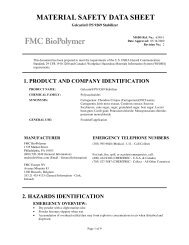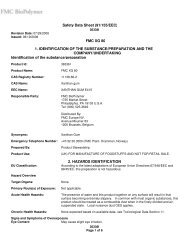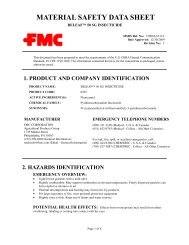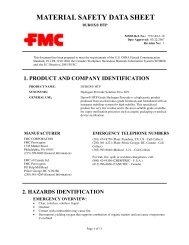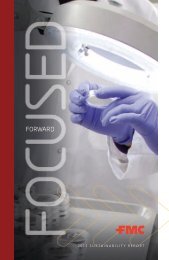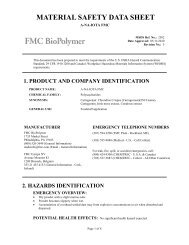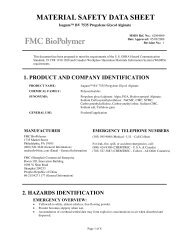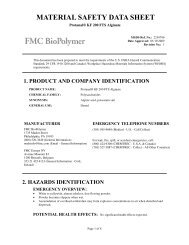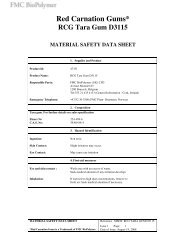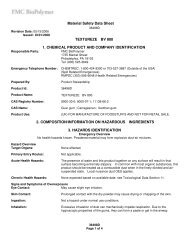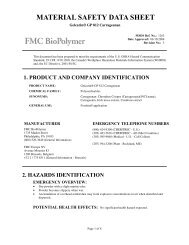MATERIAL SAFETY DATA SHEET - FMC Corporation
MATERIAL SAFETY DATA SHEET - FMC Corporation
MATERIAL SAFETY DATA SHEET - FMC Corporation
Create successful ePaper yourself
Turn your PDF publications into a flip-book with our unique Google optimized e-Paper software.
Peradigm (F18-55-9) Date: 03/11/2010<br />
Proprietary Component #1: Repeated or prolonged exposures may cause blackening and hyperkeratosis of<br />
the skin, bronchitis and pharyngitis, erosion of exposed front teeth, and chronic inflammation of the nose<br />
throat and bronchial tubes. Chronic exposures at levels up to 200 ppm has produced palpebral edema,<br />
hypertrophy of lymph nodes and conjunctival hyperemia. Persons with pre-existing skin disorders or eye<br />
problems, or impaired respiratory function may be more susceptible to the effects of this substance.<br />
Teratogenicity testing has been reported to be negative in mice, rats, rabbits, hamsters and guinea pigs. This<br />
component has been tested and has not been shown to cause cancer, or to have reproductive effects.<br />
Proprietary Component #2: Chronic or heavy ingestion may cause tooth enamel erosion. Large oral doses<br />
may cause severe metabolic acidosis, hyperkalemia, hypotension and tachycardia. This component was not<br />
mutagenic in Salmonella typhimurium in the presence or absence of metabolic activation, and it did not<br />
induce chromosome aberrations in cultured Chinese hamster fibroblast cells; nor was it not shown to be a<br />
reproductive hazard in animals. Rats fed 1.2% for 90 weeks experienced no harmful effects on growth,<br />
reproduction, blood values, pathology or calcium levels, and slight dental attrition was seen. The actual<br />
human reproductive hazard is unknown, but it is not expected to be significant as it is a normal metabolite.<br />
No teratogenic effect was observed among the offspring of mice, rats, hamsters, or rabbits treated with<br />
large doses during pregnancy. This component is not expected to be genotoxic at physiological<br />
concentrations because it is a normal metabolite<br />
Proprietary Component #3: Ingestion of sizable amounts can cause a syndrome evidenced by abdominal<br />
pain, vomiting, increased respiration and mental disturbances. Fatalities resulting from respiratory or<br />
cardiovascular failure are known. Mean lethal adult ingestion dose is between 20 and 30 grams. When<br />
given to pregnant rats and rabbits at high doses, increased congenital malformations occurred, primarily<br />
involving the skeleton and central nervous system. This component, an NSAID, may play a role in at least<br />
one type of female infertility. Prostaglandin inhibition appears to increase the incidence of luteinized<br />
unruptured follicle syndrome, a condition in which normal ovarian follicular development is followed by an<br />
elevation of serum progesterone compatible with ovulation, but the cycle remains anovulatory because the<br />
follicular wall remains unruptured. Animal and human oral data suggests that the reduced clearance by<br />
neonates may result in drug accumulation and toxic effects when repeated oral exposures are small.<br />
Because of these concerns, the WHO Working Group on Human Lactation classified this component as<br />
unsafe for use by nursing women.<br />
CARCINOGENICITY:<br />
NTP: Not listed<br />
IARC: Not listed<br />
OSHA: Not listed<br />
OTHER: ACGIH: Not listed<br />
12. ECOLOGICAL INFORMATION<br />
ENVIRONMENTAL <strong>DATA</strong>: No data available.<br />
ECOTOXICOLOGICAL INFORMATION: No data available for the product.<br />
Proprietary Component #1<br />
96-hour LC50 = 88 mg/L (Pimephales promelas)<br />
96-hour LC50 = 75 mg/L (Lepomis macrochirus)<br />
72 to 96-hour LC50 = 88 mg/L (Fathead minnows)<br />
Page 6 of 11



